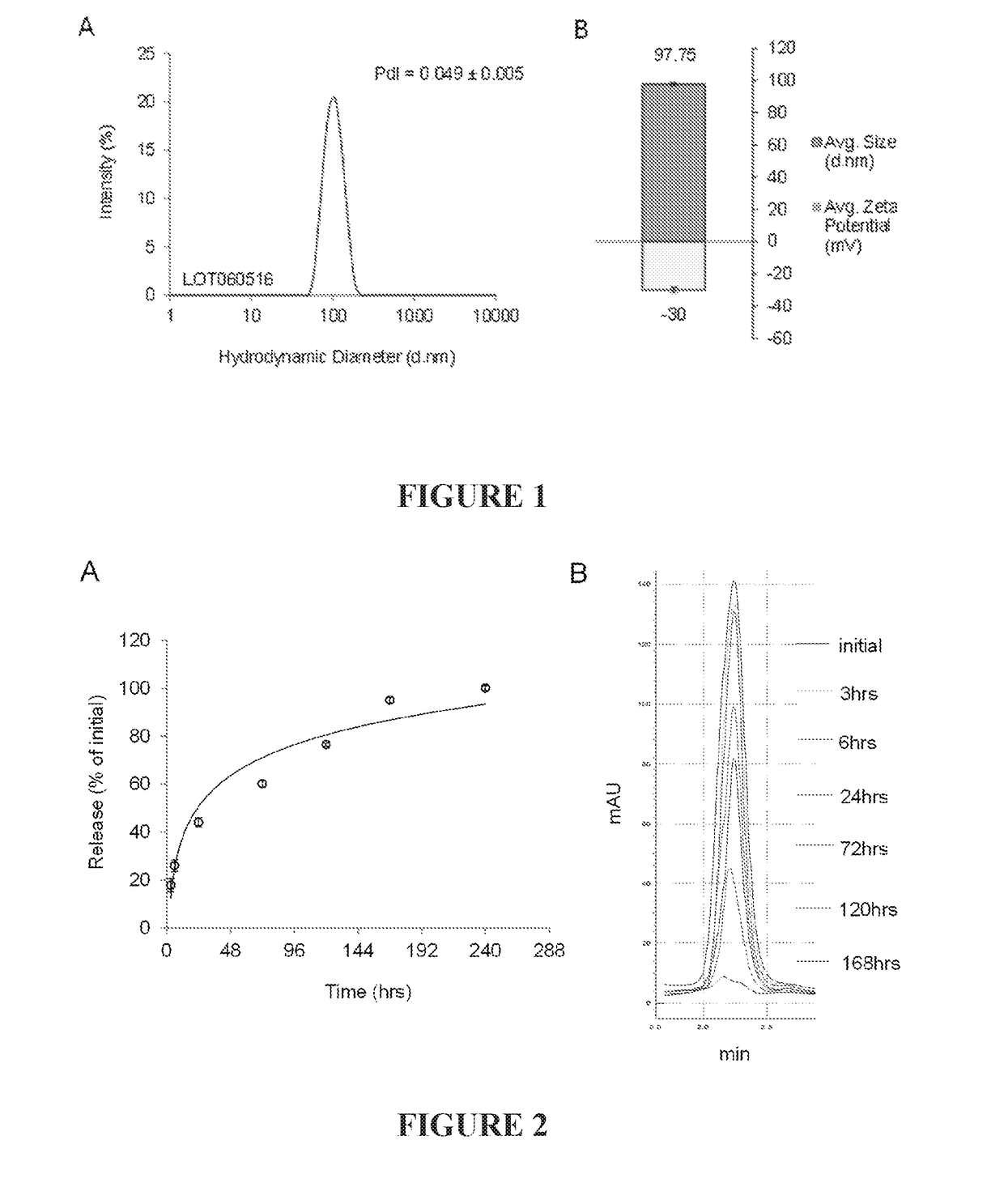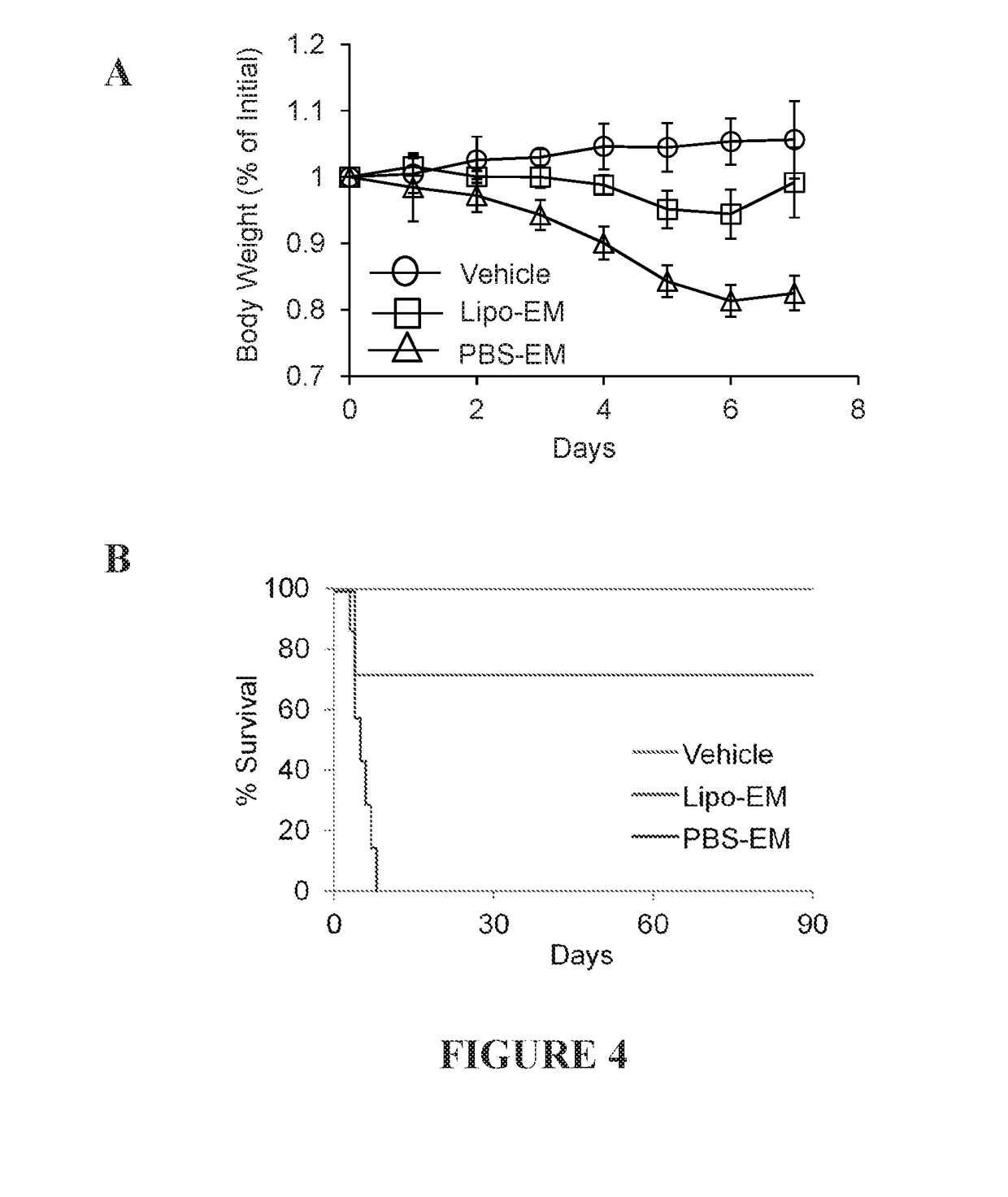Echinomycin Formulation, Method of Making and Method of Use Thereof
a technology of echinomycin and formulation, applied in the field of echinomycin formulation, method of making, can solve the problems of echinomycin as employed in these studies not showing significant antitumor activity in previously treated patients, no pharmacokinetics (pk) data emerged, and clinical development of echinomycin was halted
- Summary
- Abstract
- Description
- Claims
- Application Information
AI Technical Summary
Benefits of technology
Problems solved by technology
Method used
Image
Examples
example 1
on of Liposomal Echinomycin Formulations
[0168]Lipid components and echinomycin were weighed out on an analytical balance and dissolved in a suitable solvent, such as chloroform / methanol 2:1 (v / v), at the appropriate ratios in a glass scintillation vial and mixed by vortex. A slow stream of nitrogen gas was used to evaporate the organic solvent and produce a homogeneous lipid film on the walls of the glass vial. To prevent gelation, the drying process was carried out at 65° C. The lipid film was hydrated by adding 10% sucrose (w / v) in double distilled water (ddH2O) pre-heated to 65° C., such that the final concentration of total lipids was 7.1 mg / mL. The hydrated mixture was maintained above 65° C. and mixed vigorously by vortex until all of the film was dissolved. The hydrated solution of large multilamellar vesicles (LMV) was extruded extensively across 200 nm, 100 nm, and 50 nm stacked polycarbonate (PC) filters using an Avanti Mini-Extruder in 1 mL increments until the average si...
example 2
ribution and Physical Characterization of Liposomal Echinomycin
[0177]Liposomal echinomycin formulations were characterized using Malvern Zetasizer software to determine average size and zeta potential. The size distribution was consistently found to be within a very narrow range with a polydispersity index of less than 0.1, as shown in the representative dynamic light scattering (DLS) profile in FIG. 1, panel A. Accumulation of liposomes in tumor tissues by enhanced permeability and retention (EPR) and maximal immunoevasive properties of PEGylated stealth liposomes from rapid uptake by the reticuloendothelial system (RES) has been reported for liposomes <100 nm in size. The average hydrodynamic diameter of liposomal echinomycin was found to be about 98 d·nm; this was easily reproduced between batches (FIG. 1, panel B).
[0178]Measurement of zeta potential of liposomal formulations can provide reliable method for predicting particle stability and tendency to aggregate. The average zeta...
example 3
Release of Echinomycin from Liposomal Echinomycin
[0179]An
[0180]evaluation of in vitro drug release from liposomal echinomycin was done via dialysis by measuring the release rate of echinomycin over a period of 240 hours by HPLC at each time point at room temperature in water. Echinomycin concentrations were calculated for each time-point according to an echinomycin standard curve. Calculations of percent release were derived as a function of the initial echinomycin concentration detected in the liposomal echinomycin sample before starting dialysis. The in vitro release characteristics of liposomes are summarized in the cumulative percentage release shown in FIG. 2, panel A. Representative HPLC chromatograms showing echinomycin peaks at corresponding time-points are plotted in FIG. 2, panel B.
PUM
| Property | Measurement | Unit |
|---|---|---|
| diameter | aaaaa | aaaaa |
| average molecular mass | aaaaa | aaaaa |
| average molecular mass | aaaaa | aaaaa |
Abstract
Description
Claims
Application Information
 Login to View More
Login to View More - R&D
- Intellectual Property
- Life Sciences
- Materials
- Tech Scout
- Unparalleled Data Quality
- Higher Quality Content
- 60% Fewer Hallucinations
Browse by: Latest US Patents, China's latest patents, Technical Efficacy Thesaurus, Application Domain, Technology Topic, Popular Technical Reports.
© 2025 PatSnap. All rights reserved.Legal|Privacy policy|Modern Slavery Act Transparency Statement|Sitemap|About US| Contact US: help@patsnap.com



